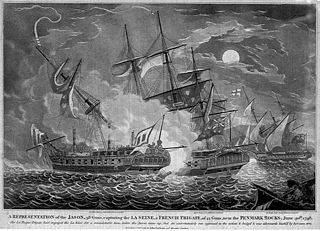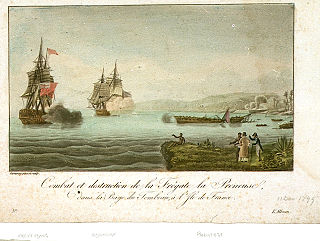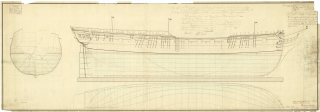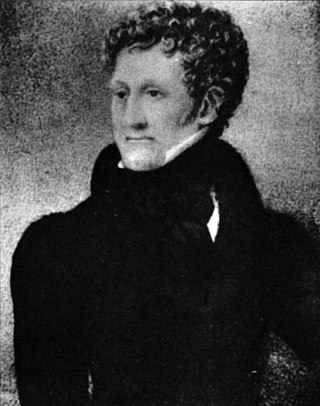
HMS Arethusa was a 38-gun Minerva-class fifth-rate frigate of the Royal Navy built at Bristol in 1781. She served in three wars and made a number of notable captures before she was broken up in 1815.

HMS Anson was a ship of the Royal Navy, launched at Plymouth on 4 September 1781. Originally a 64-gun third rate ship of the line, she fought at the Battle of the Saintes.

HMS Apollo, the third ship of the Royal Navy to be named for the Greek god Apollo, was a 38-gun Artois-class fifth rate frigate of the Royal Navy. She served during the French Revolutionary Wars, but her career ended after just four years in service when she was wrecked on the Haak sands off the Dutch coast.
HMS Lively was a 32-gun fifth-rate Alcmene-class frigate of the British Royal Navy launched on 23 October 1794 at Northam. She took part in three actions – one a single-ship action, one a major battle, and one a cutting-out boat expedition – that would in 1847 qualify her crews for the issuance of the Naval General Service Medal. Lively was wrecked in 1798.

Minerve was a 40-gun Minerve-class frigate of the French Navy. The British captured her twice and the French recaptured her once. She therefore served under four names before being broken up in 1814:
Nine ships and one shore establishment of the Royal Navy have been named HMS Wasp, with one other government vessel using the name:
Twelve ships of the Royal Navy have borne the name HMS Mosquito, or the archaic HMS Musquito, after the tropical insect, the Mosquito:

HMS Castor was a 32-gun Amazon-class fifth-rate frigate of the Royal Navy. She served during the French Revolutionary and Napoleonic Wars. The French briefly captured her during the Atlantic Campaign of May 1794 but she spent just 20 days in French hands as a British ship retook her before her prize crew could reach a French port. Castor eventually saw service in many of the theatres of the wars, spending time in the waters off the British Isles, in the Mediterranean and Atlantic, as well as the Caribbean.

HMS Juno was a Royal Navy 32-gun Amazon-class fifth rate. This frigate served during the American War of Independence, and the French Revolutionary and Napoleonic Wars.

HMS Jason was a 38-gun Artois-class fifth-rate frigate of the Royal Navy. She served during the French Revolutionary Wars, but her career came to an end after just four years in service when she struck an uncharted rock off Brest and sank on 13 October 1798. She had already had an eventful career, and was involved in several engagements with French vessels.

Charles Lydiard was an officer of the Royal Navy who served during the French Revolutionary and Napoleonic Wars.

Corona was a 40-gun Pallas-class frigate of the Italian Navy. The French built her in Venice in 1807 for the Napoleonic Kingdom of Italy. The British captured Corona at the Battle of Lissa and took her into the Royal Navy as HMS Daedalus. She grounded and sank off Ceylon in 1813 while escorting a convoy.
HMS Alcmene was a 32-gun Alcmene-class fifth rate of the Royal Navy. This frigate served during the French Revolutionary and Napoleonic Wars under the command of several notable officers. Alcmene was active in several theatres of the war, spending most of her time cruising in search of enemy vessels or privateers, and escorting convoys. She fought at the Battle of Copenhagen in 1801 and served in the blockade of the French coasts during the later Napoleonic Wars until she was wrecked on the French coast in 1809.

HMS Adamant was a 50-gun Portland-class fourth rate warship of the British Royal Navy. She served during the American War of Independence, the French Revolutionary Wars, and the Napoleonic Wars in a career that spanned thirty years.

The action of 4 April 1808 was a naval engagement off the coast off Rota near Cadiz, Spain where Royal Naval frigates Mercury, Alceste and Grasshopper intercepted a large Spanish convoy protected by twenty gunboats and a train of batteries close to shore.

HMS Diana was a 38-gun Artois-class fifth rate frigate of the Royal Navy. She was launched in 1794.

Rear-Admiral James Macnamara was an officer of the Royal Navy who served during the American War of Independence and the French Revolutionary and Napoleonic Wars.

HMS Venus was the name ship of the 36-gun Venus-class fifth-rate frigates of the Royal Navy. She was launched in 1758 and served for more than half a century until 1809. She was reduced from 36 to 32 guns in 1792. She was sold in 1822.
HMS Zenobia was a schooner of the Adonis class of the Royal Navy during the Napoleonic War. She was built and completed at Bermuda using Bermuda cedar in 1806 and commissioned under Lieutenant Archibald Hamilton. She sailed for Norfolk, Virginia, on 22 October 1806.

HMS Arethusa was a 46-gun Leda-class fifth-rate frigate built for the Royal Navy during the 1810s. The ship was never commissioned and was converted into a lazarette in 1836. She was renamed HMS Bacchus in 1844 and was further converted into a coal hulk in 1851–52. The ship was sold for scrap in 1883.















